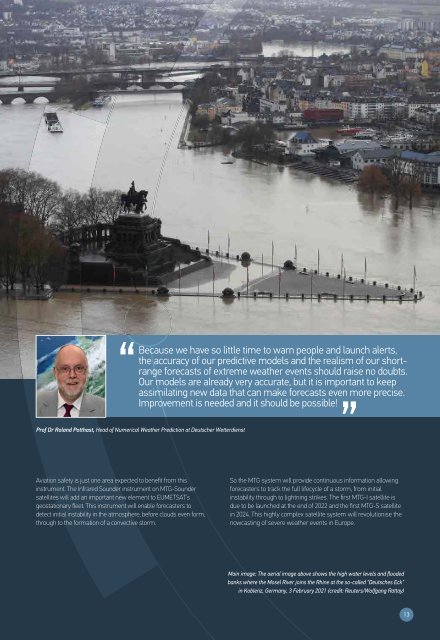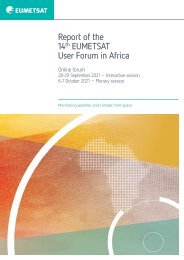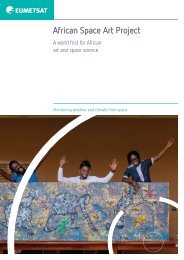EUMETSAT Annual Report 2021
Create successful ePaper yourself
Turn your PDF publications into a flip-book with our unique Google optimized e-Paper software.
<strong>EUMETSAT</strong> ANNUAL REPORT <strong>2021</strong><br />
“<br />
Because we have so little time to warn people and launch alerts,<br />
the accuracy of our predictive models and the realism of our shortrange<br />
forecasts of extreme weather events should raise no doubts.<br />
Our models are already very accurate, but it is important to keep<br />
assimilating new data that can make forecasts even more precise.<br />
Improvement is needed and it should be possible!<br />
”<br />
Prof Dr Roland Potthast, Head of Numerical Weather Prediction at Deutscher Wetterdienst<br />
Aviation safety is just one area expected to benefit from this<br />
instrument. The Infrared Sounder instrument on MTG-Sounder<br />
satellites will add an important new element to <strong>EUMETSAT</strong>’s<br />
geostationary fleet. This instrument will enable forecasters to<br />
detect initial instability in the atmosphere, before clouds even form,<br />
through to the formation of a convective storm.<br />
So the MTG system will provide continuous information allowing<br />
forecasters to track the full lifecycle of a storm, from initial<br />
instability through to lightning strikes. The first MTG-I satellite is<br />
due to be launched at the end of 2022 and the first MTG-S satellite<br />
in 2024. This highly complex satellite system will revolutionise the<br />
nowcasting of severe weather events in Europe.<br />
Main image: The aerial image above shows the high water levels and flooded<br />
banks where the Mosel River joins the Rhine at the so-called "Deutsches Eck"<br />
in Koblenz, Germany, 3 February <strong>2021</strong> (credit: Reuters/Wolfgang Rattay)<br />
13









